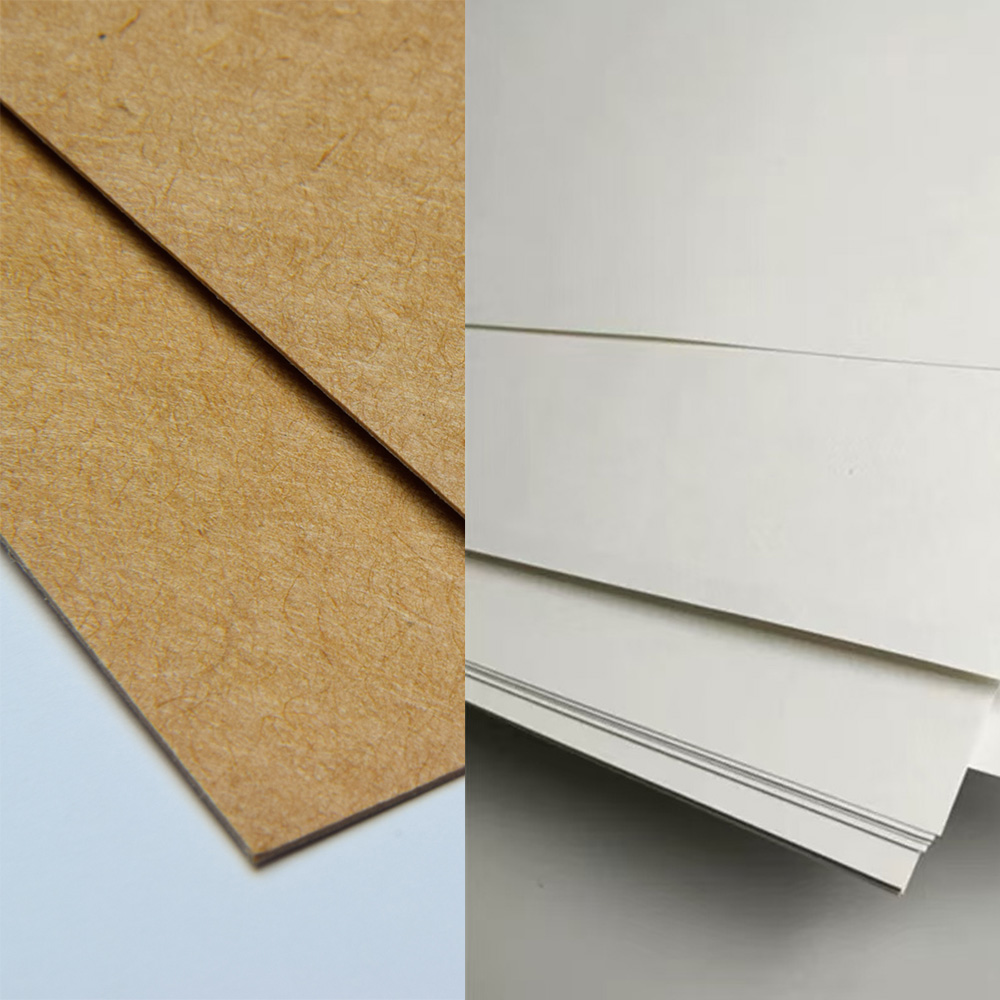1) Basics and naming
White kraft (Bleached Kraft): Made mainly from long fibers and bleached to a high, neutral whiteness. The sheet looks cleaner and delivers stronger print contrast.
Natural kraft (Unbleached / Brown Kraft): The unbleached version with a brown/khaki tone and visible fibers. Strength is typically on par with white kraft at the same grade and basis weight.
Note on “kraft”: It doesn’t mean leather. It simply means tough paper. Kraft can be used for bags, sleeves, inner wraps and tags, or as the liners of corrugated board to take stacking loads.
2) Key differences at a glance
Look & brand tone: White kraft = clean, neutral base with high color fidelity. Natural kraft = earthy, minimalist feel and a stronger eco signal.
Print appearance: White kraft handles high-saturation graphics, photo images and fine screens well. On natural kraft, colors read warmer and a bit darker; use a white underprint for bright hues.
Strength & durability: At the same gsm/grade, the two are very similar. Sack/kraftliner grades in either color can reach high strength; structure and design matter more than color.
Surface & runnability: White kraft is usually a little smoother and shows fine detail better. Natural kraft absorbs more ink—control dot gain and ink laydown.
Cost perception: White kraft often prices slightly higher due to bleaching and whiteness grade. Natural kraft is typically more cost-effective and broadly available.
Sustainability messaging: Both can be responsibly sourced and recyclable. Natural kraft’s brown look communicates “eco” more directly.
3) Common specs (plain-language guide)
Basis weight (GSM):
White kraft: roughly 70–200 gsm for bags/sleeves; 200–300 gsm for board-weight uses.
Natural kraft: roughly 50–200 gsm for bags/mailers/sleeves; 200–300 gsm for board-weight uses.
Caliper (thickness): Typically ~60–230 μm depending on gsm and machine settings.
Cobb 60s (water absorbency): Uncoated grades are often ~20–60 g/m²·60s; choose lower Cobb or add a barrier if you need better moisture resistance.
Tensile / burst / tear: Generally medium-to-high; sack and linerboard grades are notably strong.
Whiteness / tone: White kraft = high, neutral white; natural kraft = brown/khaki with visible fiber specks.
Reality check: performance depends on mill recipe, refining, pressing/drying and coatings. Treat the ranges above as typical, and confirm with supplier data and samples.
4) Printing & finishing in practice
White kraft
Best for: strict brand colors, photo-level images, large solid backgrounds, small text and fine lines.
Tips: CMYK and spot colors reproduce cleanly. Control sheet moisture and setoff; add an aqueous varnish if you need extra scuff resistance.
Natural kraft (brown)
Best for: natural/minimalist art direction, bold spot colors, strong linework and generous white space.
Tips: For vivid or light colors, lay down white first. Avoid huge areas of very light tints on raw brown stock.
Shared advice
Choose flexo for cost-effective volume, offset for high detail, digital for short runs and versioning.
Prefer water-based/soy inks and aqueous coatings.
Set die-cut and crease rules to gsm and grain to avoid cracking.
Use water-based PVA or hot-melt adhesives and test peel and tensile strength before production.
5) Typical uses & quick selection
E-commerce & parcel
White kraft: subscription boxes and outer panels where bright artwork must pop.
Natural kraft: paper mailers, corrugated outer faces, honeycomb/expanded kraft and roll void fill—great value and an eco-first look.
Retail & gifting
White kraft: premium shopping bags, cosmetics/food sleeves, gift belly bands with fine graphics.
Natural kraft: earthy sleeves, hangtags and bags—pair with spot colors and generous white space for a handcrafted feel.
Labels & cards
White kraft: crisp barcodes, small text, fine screens.
Natural kraft: vintage/handmade labels and price tags; add scuff-resistant varnish for heavy handling.
Food & takeaway
Both are viable with the right barrier (grease/moisture/heat-seal) and food-contact compliance.
Choose white for a clean, bright look; choose natural for a stronger sustainability message.
6) Cost and supply notes
Pricing: White kraft typically carries a modest premium; natural kraft is budget-friendly for large runs.
Lead time & consistency: Whiteness targets and coatings can affect scheduling. For either color, good humidity control and incoming QC drive consistent results.
Recycled content: Natural kraft often comes with recycled options; white kraft can too, but balance look and strength against brand expectations.
